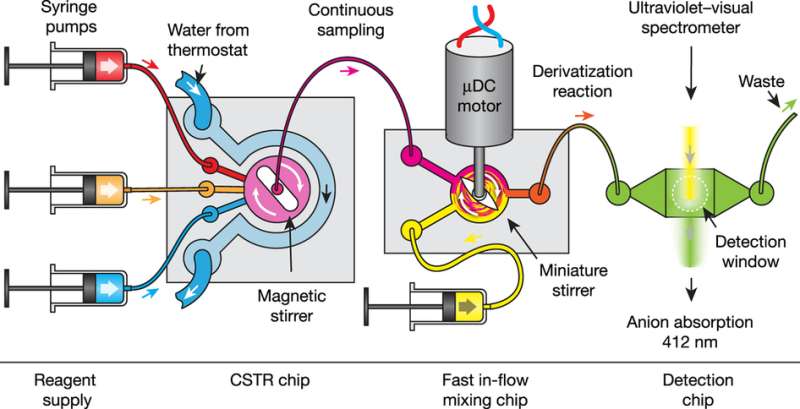September 29, 2016 report
Researchers demonstrate a few-component system of interacting organic species that displays autocatalytic features

(Phys.org)—A team of researchers at Harvard University has demonstrated a few-component system of interacting organic species that, when combined into a reaction network, displayed autocatalytic and oscillatory features—a first. In their paper published in the journal Nature, the team explains how they developed their process and why they believe it may lead to a better understanding of the factors that led to the formation of life on Earth. Annette Taylor with the University of Sheffield in the U.K. offers a News & Views piece on the work done by the team in the same journal issue, outlining the work and explaining why it does not necessarily mean that scientists are now close to creating life in a petri dish.
As Taylor notes, one of the things that defines something as being alive is its ability to self-replicate; thus, research looking into how life got its start has focused on searching for chemical combinations that self-replicate when they react, aka, autocatalytic processes. For many years, researchers built models of what they thought autocatalysis would look like, but then a half-century ago, Boris Belousov found oscillations in chemical systems that behaved as autocatalytic processes—but such systems typically were not simple. In this new effort, the researchers have now overcome that hurdle by creating examples of autocatalysis that demonstrated complex behavior using only simple organic compounds.
The team carried off this trick by building a network with organic molecules that contained sulfur, which were called thiols and thioesters, and notably included no enzymes—reactions occurred and then kept on occurring so long as the researchers continued to add thioesters as a fuel, akin to adding fuel to a fire to keep it burning. In so doing, they found that they could cause the system to resemble a bistable switch with a memory function—which, as they note, is also quite common in living organisms.
As Taylor further notes, the results achieved by the team at Harvard are intriguing and could lead to further understanding of how life may have started, but there is still much more to learn, such as how cells formed with their protective walls, which were necessary for the formation of higher life forms.
More information: Sergey N. Semenov et al. Autocatalytic, bistable, oscillatory networks of biologically relevant organic reactions, Nature (2016). DOI: 10.1038/nature19776
Abstract
Networks of organic chemical reactions are important in life and probably played a central part in its origin. Network dynamics regulate cell division, circadian rhythms7, nerve impulses8 and chemotaxis, and guide the development of organisms10. Although out-of-equilibrium networks of chemical reactions have the potential to display emergent network dynamics such as spontaneous pattern formation, bistability and periodic oscillations, the principles that enable networks of organic reactions to develop complex behaviours are incompletely understood. Here we describe a network of biologically relevant organic reactions (amide formation, thiolate–thioester exchange, thiolate–disulfide interchange and conjugate addition) that displays bistability and oscillations in the concentrations of organic thiols and amides. Oscillations arise from the interaction between three subcomponents of the network: an autocatalytic cycle that generates thiols and amides from thioesters and dialkyl disulfides; a trigger that controls autocatalytic growth; and inhibitory processes that remove activating thiol species that are produced during the autocatalytic cycle. In contrast to previous studies that have demonstrated oscillations and bistability using highly evolved biomolecules (enzymes and DNA) or inorganic molecules of questionable biochemical relevance (for example, those used in Belousov–Zhabotinskii-type reactions), the organic molecules we use are relevant to metabolism and similar to those that might have existed on the early Earth. By using small organic molecules to build a network of organic reactions with autocatalytic, bistable and oscillatory behaviour, we identify principles that explain the ways in which dynamic networks relevant to life could have developed. Modifications of this network will clarify the influence of molecular structure on the dynamics of reaction networks, and may enable the design of biomimetic networks and of synthetic self-regulating and evolving chemical systems.
Journal information: Nature
© 2016 Phys.org





















